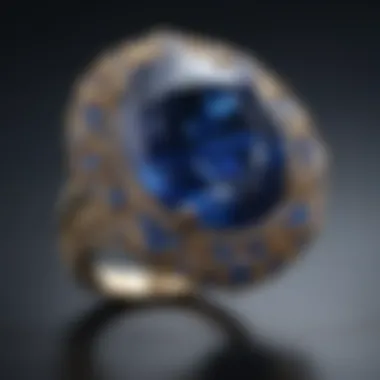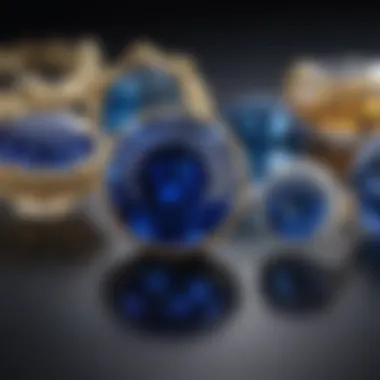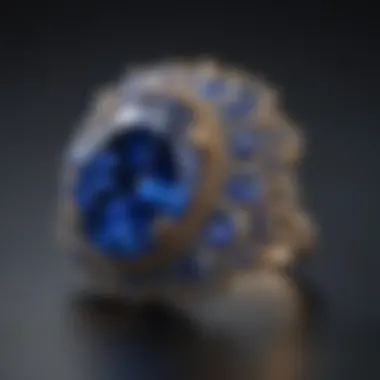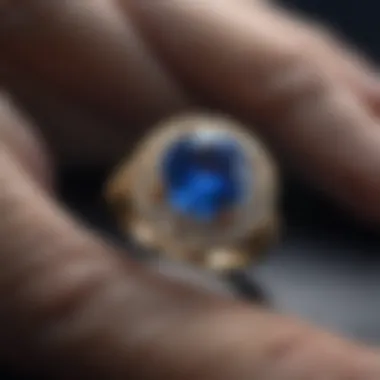Understanding Kashmir Blue Sapphire: Pricing Insights


Intro
Kashmir blue sapphire is one of the most coveted gemstones in existence. Renowned for its stunning hue and historical significance, it embodies a remarkable blend of rarity and beauty. In this section, we will embark on a comprehensive journey through the world of gemstones and, in particular, focus on the fascinating aspects of Kashmir blue sapphire's pricing and market insights.
Overview of Gemstones and Minerals
The term gemstones refers to natural minerals or rocks that are cut and polished for use in jewelry and adornment. The market for gemstones is multifaceted, and understanding the immense significance these minerals have in various societies is crucial.
History of Gemstone and Mineral Use
Throughout history, gemstones have been more than mere decorations. In ancient civilizations, they held spiritual significance and were linked to status. Amulets adorned with jade in China, lapis lazuli in Mesopotamia, and diamonds among Indian royalty underline this deep-seated connection. For centuries, regions renowned for their precious stones have faced challenges, including accessibility and illegal mining. Our focus now turns to Kashmir blue sapphire, a gemstone with both a majestic history and considerable economic value.
Significance in Culture and Society
Culturally, gemstones have often been employed as symbols of power and protection. For instance, the Kashmir blue sapphire has a unique place in diamond mythology due to its association with royalty and divine favor. Owning a Kashmir blue sapphire is considered a sign of sophistication and knowledge within the gemstone trade. Discussions on gemstone prices are often intertwined with broader themes of beauty, value, and societal implications. This discussion adds depths to the ongoing interest in gemstones.
Gemstone Formation and Properties
To grasp the peak prices on Kashmir blue sapphires, understanding their formation and characteristics is essential.
Formation Process of Gemstones
Gemstones are typically formed under specific geological processes that assess factors like temperature, pressure, and time. Kashmir blue sapphires, found primarily in the Himalayan region, are formed in metamorphic rock through the cooling of mineral rich solutions. Their rarified formation conditions add intrigue and value to these stunning stones.
Properties that Define Gemstones
Gemstones possess unique properties setting them apart, including hardness, clarity, cut, and color. Kashmir blue sapphires are notable for their striking deep blue color and exceptional clarity. These quality traits reduce light interference and enhancing overall brilliance.
Classification based on Color, Hardness, and Luster
Gemstones are often evaluated based on color, hardness measured by the Mohs scale, and luster which refers to the way light reflects off the surface. Kashmir blue sapphire scores high on all these properties, contributing significantly to their primary appeal in the market, and subsequently their elevated prices.
Prelims to Kashmir Blue Sapphire
The Kashmir blue sapphire is a highly coveted gemstone known for its exquisite deep blue hue and historical significance. This introduction serves to underscore the gemstone's rarity and the nuances that make it a fascinating subject for gemstone enthusiasts, collectors, and industry professionals. As we dissect this topic, it will become clear that understanding the intrinsic elements of Kashmir blue sapphire is vital for informed purchasing decisions and investment considerations.
Historical Context
The history of Kashmir blue sapphire is rich and complex, having gained fame during the late 19th century when it was first discovered in the Himalayas. Located in the Kashmir region of India, this gemstone was mined in limited quantities, leading to its present-day rarity and high demand. The political instability in the area since then has also hindered access to new sources. The fame of these sapphires soared due to their unique color and brilliance, creating a global market for this exceptional stone. The cultural aspects surrounding these stones further enhance their allure, as they are often linked to royalty and prestige.
Characteristics of Kashmir Blue Sapphire
Kashmir blue sapphires are distinguished by their vibrant color and exceptional quality. The most defining characteristic is their royal blue color, which can vary slightly in hue depending on the lighting. This variance adds depth and beauty to the stone, captivating those who gaze upon it. Clarity is another important characteristic, with top-tier sapphires showcasing negligible inclusions. Generally, the clearer the stone, the more valuable it is. Moreover, the cut quality of these sapphires is paramount; an expert cut enhances their brilliance and light performance. Regarding size, larger Kashmir blue sapphires command a higher price tag, exhibiting their rarity even further.
The tangible qualities and finite nature of Kashmir blue sapphires make them particularly sought after in the gem market. For those engaged in the world of gems and jewelry, knowing about these characteristics is essential for understanding their overall value and market worth.


Factors Affecting Price Per Carat
Understanding the pricing of Kashmir blue sapphire goes beyond mere numbers; it involves delving into various elements that shape its value. Each sapphire is unique, and pricing can vary significantly based on distinct factors. This section unpacks those factors that influence the price per carat, aiding buyers in making well-informed decisions.
Origin and Rarity
Origin plays a crucial role in determining the price per carat of Kashmir blue sapphire. The gem's provenance is not just a label; it is a measure of quality and market demand. Kashmir sapphires are rare. Most of the supply originates from mines in Kashmir, which have been either depleted or restricted. This rarity inherently increases their market value. The allure of having a stone with a distinguished background means collectors and enthusiasts are often ready to pay a premium. Its esteemed origin can influence perceptions of quality, making Kashmir sapphires some of the most prized and sought-after gems.
Color and Clarity
Another significant factor is color and clarity. Kashmir blue sapphires are known for their deep, velvety blue hues. When assessing color, intensity and saturation come into play. Those sapphires with vivid color, balanced with undertones of violet, often fetch higher prices. Clarity is equally important; inclusions and blemishes can dramatically affect value. A cleaner stone lessens light obstruction and maximizes brilliance, leading to elevated price. Selecting a Kashmir sapphire with ideal color and clarity ratings is essential for optimal investment.
Cut Quality
Cut quality greatly influences the price of any gemstone, and Kashmir blue sapphires are no exception. Well-cut stones allow for maximum light reflection, enhancing brilliance. An expertly crafted sapphire will display a vivid play of light, resulting in higher demand and price. The cut also affects how the color is perceived—good cutting brings out the depth of color inherent to the sapphire, ensuring it captivates as intended. Buyers should closely scrutinize cut quality to appreciate its immediate impact on overall value.
Size and Weight
Lastly, the size and weight of the gemstone directly relate to its pricing structure. Larger Kashmir blue sapphires are exceedingly rare. When price per carat rises with increased size, potential buyers must evaluate their budget against an appealing gem. While sizable stones garner more attention, smaller stones can still hold value, especially if they possess exceptional color and clarity. Weight adds layers to pricing, combining accolades of extraordinary attributes with physical dimensions, creating a comprehensive investing condition.
In summary, pricing Kashmir blue sapphires involves careful consideration of origin, color, clarity, cut quality, and size. Each factor is interconnected and essential for understanding the true value of these gems.
Current Market Trends
Current market trends play a crucial role in comprehending the pricing dynamics of Kashmir blue sapphire. By analyzing trends, buyers can make more informed decisions based on evolving variations in value and demand. This understanding can also help investors navigate the gemstone market, placing their investments more effectively. There are two significant aspects to focus on within these trends: historical price fluctuations and price comparisons with other types of sapphires.
Historical Price Trends
Kashmir blue sapphire has experienced notable changes in price over time, linked to both availability and shifting consumer preferences. Historically, these sapphires have held their value well, attributed to their rarity. Several economic factors like supply limitations and mining explorations in Kashmir have intensified over the years, drastically affecting price. Reports indicate that Kashmir blue sapphires have remained resilient in demand, with prices generally seeing an increasing trend.
Recent data shows notable spikes in prices during economic hemisphere shifts, creating various purchasing opportunities or challenges. Larger carats tend to see more significant valuation adjustments due to rarity. Items dating back generations and having a third-party appraisal can fetch even higher market prices.
"The demand for Kashmir blue sapphires remains high, demonstrating their allure and rarity. Many collectors view them not just as gemstones, but as artistic heirlooms."
Attention spans toward pressure levels matter when interpreting historical trends. Monitoring these fluctuations can aid potential buyers to recognize ideal times for acquisition.
Comparative Pricing with Other Sapphires
Pricing for Kashmir blue sapphires often eclipses that of other sapphires due to their distinct qualities. While blue sapphires from regions like Sri Lanka or Madagascar offer many appealing characteristics, they simply do not match the deep color saturation and origin prestige of Kashmir.
When comparing prices:
- Sri Lankan Blue Sapphires: Generally more accessible in the market. Prices range from moderate to premium based on clarity and colors. However, they lack the same prestige.
- Myanmar Blue Sapphires: Prices vary as well but also traditionally remain below those of Kashmir counterparts, despite solid quality.
- Australian Sapphires: Often regarded for unique colors, but these can still fall behind Kashmir in price or intrigue.
These comparative insights into price reinforce the notion that Kashmir blue sapphires are not merely another choice on the market but rather a significant investment worthy of conscious consideration.


Investment Considerations
The Kashmir blue sapphire holds a unique status in the gemstone market, not just for its beauty but also for its investment potential. When considering this gemstone for investment purposes, it is vital to approach the topic with a deep understanding of specific elements that could significantly influence one’s financial foresight and choices.
Long-term Value Retention
Kashmir blue sapphires are often associated with long-term value retention. This characteristic makes them attractive to investors and collectors alike. Unlike some other gemstones, the demand for Kashmir blue sapphires isn’t expected to dwindle with changing consumer preferences. Their origin from the Kashmir region has endowed them a luxury status that many seek.
Several factors contribute to this value retention:
- Rarity: Kashmir sapphires are rarer compared to other sapphires. Finding an unenhanced and high-quality stone today is becoming increasingly difficult.
- Market Scope: The ongoing global demand from high-net-worth individuals ensures continued interest. Investors usually see this as a hedge against inflation.
- Historical Context: With prices climbing dramatically over the years, historical appreciation suggests that investment in these sapphires could yield high returns.
Figuring the likelihood of long-term growth, such stones may serve effectively within a diverse investment portfolio. Considering all these aspects strengthens the case for considering Kashmir blue sapphires as significant assets in today’s market.
Market Demand Dynamics
The market dynamics for Kashmir blue sapphires provide insight into recorded trends and emerging patterns. Factors such as supply-level fluctuations, consumer preferences, and global conditions all play roles in shaping market demand.
Key Dynamics to Observe:
- Supply Constraints: Only a limited number of Kashmir sapphires are available today. That scarcity creates urgency and escalates their desirability in the market.
- Cultural Significance: The allure of sapphire service in tradition elevates its position not just as a gemstone, but as an investment icon. This culturally linked demand ensures it stays relevant.
- Economic Factors: Global economic conditions can trigger shifts in investments towards tangible assets. Luxury items, including sapphires, often see demand rise when economies face instability.
How to Verify Authenticity
Verifying the authenticity of Kashmir blue sapphires is crucial for both gemstone enthusiasts and collectors. Not all sapphires are equal, and distinguishing a genuine Kashmir blue sapphire from others can dramatically affect investment value. This section delves into the key aspects that one should consider in authenticity verification, outlining practical steps that can help assure buyers about their purchases.
Necessary Certifications
When purchasing a Kashmir blue sapphire, obtaining the right certifications is paramount. Certification from recognized gemological laboratories provides an impartial assessment of the gem’s authenticity.
Importance of Certification
- Trustworthiness: Certifications from established institutions, such as the Gemological Institute of America (GIA) or the American Gem Society (AGS), offer credibility for any gemstone declared as a Kashmir sapphire.
- Quality and Features: Certifications typically detail the sapphire's color, clarity, cut, and carat weight. This information allows potential buyers to evaluate if the gem meets their expectations and market value.
Relevant Certifying Bodies
- GIA: Renowned for robust and credible gemological services.
- AGL: Provides expert level analysis particularly focusing on colored gemstones.
Buyers should insist on viewing the certificate before finalizing any purchase. Certificates that lack detailed information could indicate the lack of rigorous evaluation.
Independent Appraisals
Independent appraisals serve as an additional layer of safety when confirming the authenticity of Kashmir blue sapphires.
Benefits of Independent Appraisals


- Neutral Evaluation: Unlike certificates issued by sellers or direct sources, independent appraisals offer a neutral perspective on the worth and authentic status of the gemstone.
- Current Market Value: An independent appraiser can provide insights on the current market value, helping buyers make informed decisions based on realistic gemstones pricing.
Key Considerations for Appraisals
- Credentials: Choose an appraiser who is certified by reputable organizations. Established credentials lead to trustworthy appraisals.
- Experience with Sapphires: Ensure the appraiser has substantial experience specifically in colored gemstones, specifically sapphires.
Always remember, a truly informed purchase can significantly elevate not just your collection but also your appreciation of these exquisite gems.
Ideal Buying Strategies
When considering the purchase of a Kashmir blue sapphire, having a strategic approach is vital. This gem's value can fluctuate significantly, and being informed can help you make the most suitable choices. Knowing where to buy is as important as knowing what to look for. This article section elaborates on optimal locations for sourcing these gemstones, alongside negotiation tactics to ensure you secure a fair deal.
Where to Buy
Finding the right retailers, auctions, or online platforms is essential to acquire a genuine Kashmir blue sapphire. Here are some reliable sources:
- Authorized jewelers: Respected jewelers often stock reputable stones and often provide certificates of authenticity.
- Gem fairs: Attending gem conventions and fairs allows you to interact directly with suppliers and experts in the field.
- Auction houses: Recognized auction houses, such as Sotheby's or Christie's, periodically auction valuable gemstones, including Kashmir blue sapphires.
- Online marketplaces: Websites like Blue Nile or James Allen may offer high-quality images and certified options, enabling safe purchases remotely.
Regardless of where you decide to buy, always verify the seller’s credentials and expect to see certification for the stones based on their quality and origin.
Negotiation Tips
Negotiating the price of a Kashmir blue sapphire can feel challenging, especially given the gemstone's premium valuation. Here are key points to keep in mind for effective negotiation:
- Do your research: Understand the current market pricing for Kashmir blue sapphires. Websites, appraisal reports, and price guides will give you insights on what is reasonable.
- Assess the quality: Use grading criteria—like color, clarity, and cut—to establish a baseline for your discussion. This equips you with knowledgeable points to address.
- Be prepared to walk away: If the price is not within your budget, maintain the willingness to leave. This could motivate the seller to rethink their offer.
- Timing and urgency: If the market is less buoyant, you may have leverage to negotiate better prices. Expressing a preparedness to wait could create more favorable conditions.
A well-informed buyer not only secures a better deal but also increases the chance of making a satisfying investment in their gemstone collection.
By adopting these buying strategies, collectors and enthusiasts can better navigate the domain of Kashmir blue sapphires and optimize their purchasing experience.
Ending
The conclusion of this article serves as a critical synthesis of the insights provided regarding Kashmir blue sapphires. Emphasizing the complexity and uniqueness of this gemstone is essential in understanding its market position. At the heart of the discussion lie the key factors influencing the price per carat, which shaped the valuation of Kashmir blue sapphires.
The rarity of these gems cannot be overstated. Their origin, primarily from the Kashmir region, along with their distinctive deep blue hue, an excellent clarity, and impressive cuts contribute to their allure. Without recognizing these attributes, one might undervalue their significance in the gemstone market.
Investment considerations also play a crucial role. As buyers delve into the realities of long-term value retention and market dynamics, knowledge provided in earlier sections equips them to navigate potential pitfalls and make informed decisions.
The focus on authenticity verification, encompassing necessary certifications and appraisals, underscores the importance of diligence for collectors and enthusiasts alike. Subsequently, strategic buying methods discussed throughout reflect pragmatic insights suited for buyers, especially in a competitive market.
Through the acquisition of this knowledge, gemstone enthusiasts, collectors, jewelry designers, and geology enthusiasts can appreciate the true value of Kashmir blue sapphires. Understanding underlying market trends and pricing dynamics establishes a solid foundation for any significant investment.
Final Thoughts on Kashmir Blue Sapphire
Kashmir blue sapphires remain amongst the most cherished variations within the sapphire family. For aficionados, understanding the metrics that guide pricing and availability is essential for securing coveted pieces.
The scarcity of high-quality stones from this region renders it imperative to stay vigilant. Acquiring educational resources and seeking authentic pieces guarantees satisfaction and long-term value.
After analyzing various aspects discussed in this article, potential buyers should feel empowered by the distinct knowledge gained. With this help, they can assess market fluctuations and contribute meaningfully to discussions within collectors' circles.
A deep appreciation for the inherent qualities of Kashmir blue sapphires not only enlightens the buyer but also solidifies the gemstone's esteemed status in jewelry history and investment circles.







